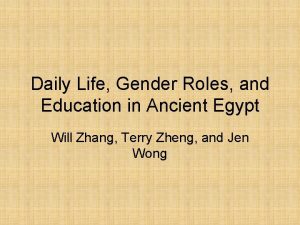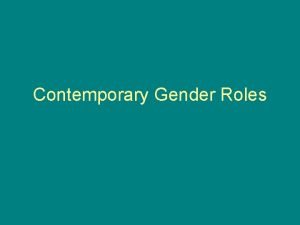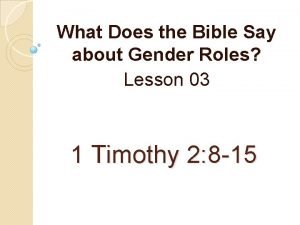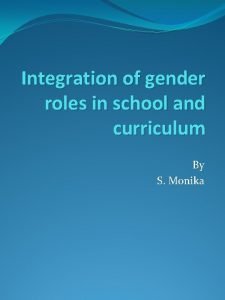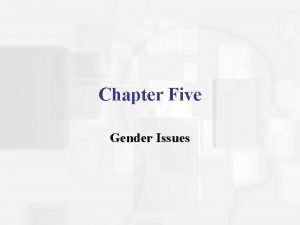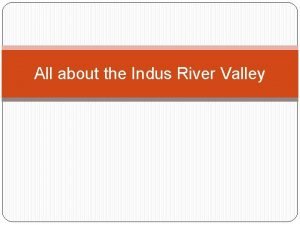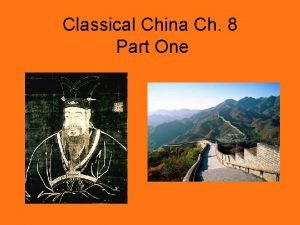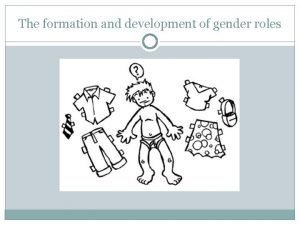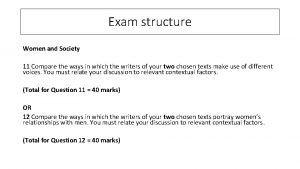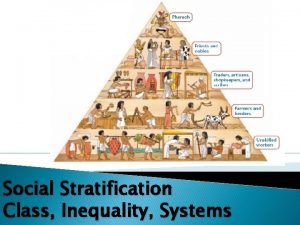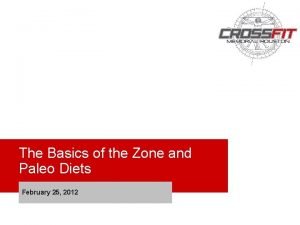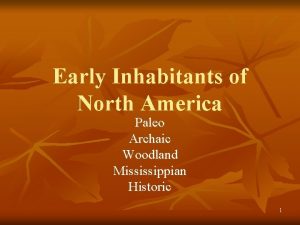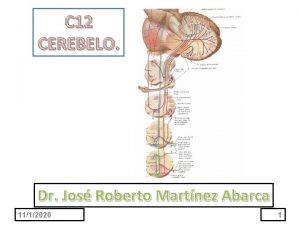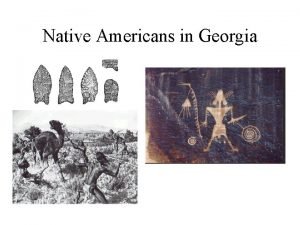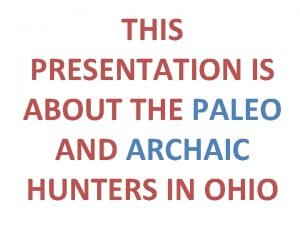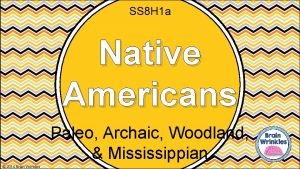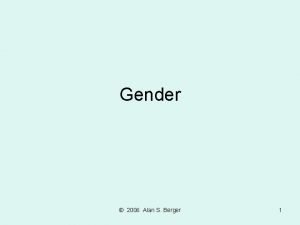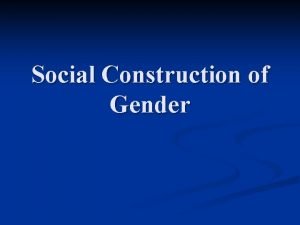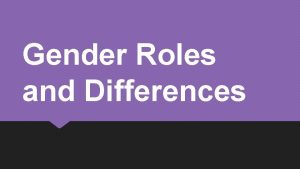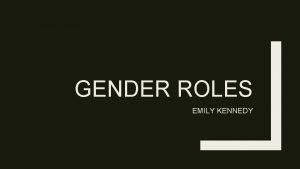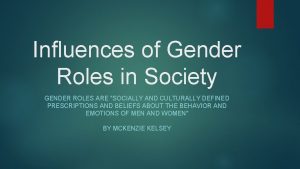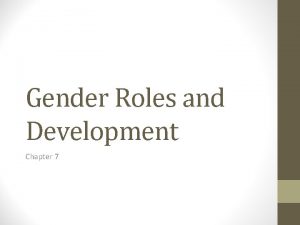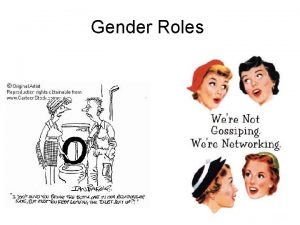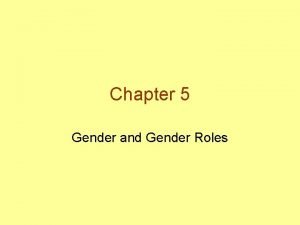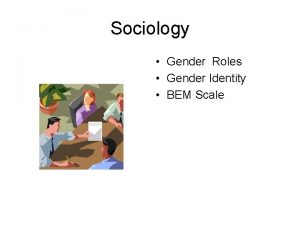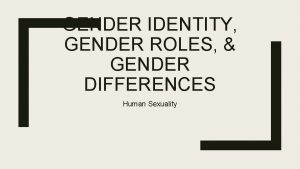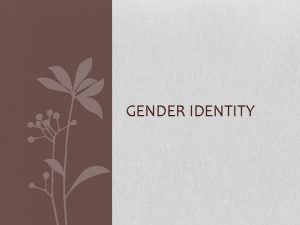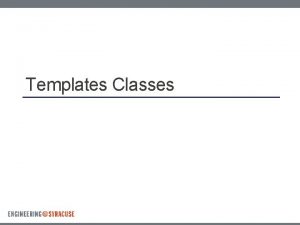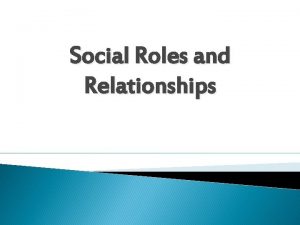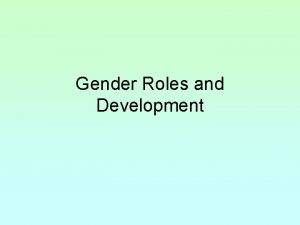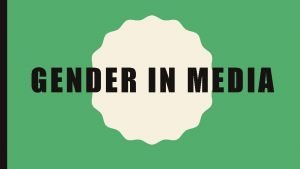Social Classes Gateway Prep Gender Roles from Paleo



































- Slides: 35

Social Classes Gateway Prep



Gender Roles – from Paleo to Neo � Women ◦ Paleolithic roles - to gathering fruits, berries, roots, and other edible naturally growing food items. �What knowledge would women need to be successful at this? ◦ Gathering of food made up a greater percentage of the caloric intake of Paleolithic society. What knowledge would women need to be successful at this? �Do you think this gave women a greater or lesser role in Paleolithic Society compared to men? ◦ Neolithic roles – the women’s knowledge of the seasons, growing cycles and edible foods helped make the Neolithic Revolution successful. �However, gender equality quicker left along with nomadism. �Women now became little more than home and baby makers. � In which society are people going to want more children? ? ?

Gender Roles – from Paleo to Neo � Men ◦ Paleolithic roles – men were the hunters in society and brought meat to the diet of nomadic societies. ◦ Neolithic roles – men became the laborers in agriculture and now brought home almost all of the calories of the diet. � Now that men are in charge of the diet and harvest, what else are they going to become in charge of.

Greece and Rome

� Athens – The Upper Class: The topmost class in the Ancient Greek Hierarchy was the Upper Class. The people of this class possessed the uppermost power and position in the society. One has to be born in Athens to be a part of the Upper Class as the rights for this class could only be inherited on the hereditary basis. The upper class symbolized a good civil character, good artistic taste, and highly socialized individuals. ◦ The people from this class handled all the government work, philosophy as well as the literature department, and also the war. Athens people always got slaves so as to perform their materialistic works so as to save their precious time which they had to use for administrative purposes. The Upper Class can also be symbolized as the Leisure Class. They kept their time for the important activities related with the administration of the kingdom. � Metics – The Middle Class: This was the next class in Ancient Greece Social Hierarchy. These people were not the natives of Athens, but came to Athens to settle down. They came to Athens for earning their livelihood. Such people were apt for the Middle Class. They were free men, they were not slaves but they possessed very little rights as compared to the Upper Class. They were majorly involved in the trading and manufacturing related jobs.

� � Freedmen – The Lower Class: Freedmen were the next class in the Ancient Greek Social Hierarchy and it incorporates those people who were once slaves but somehow were freed by their owner by any mode. This was the lower class people category but did not belong to Athens, i. e. these were neither Athens nor were granted citizenship in their life what so ever money they earned. These were the people who possessed least amount of privileges, but still got few, as compared to salves who had zero privileges. The Slaves: This is the lowest most class, actually a level because Greeks never considered it as a class. These people were either rescued from war, some criminals or even bought upon people. These people possessed zero rights or authority. They did not even possess right of their own life. Very little number of Greeks were slaves otherwise the majority of slaves were non-Greeks. They had to pay a ransom amount to buy their freedom and get themselves free.

Social Organization Family �Gravitas (seriousness) �Role of fathers was important �Role of women was less important Classes �Patricians upper class, wealthy landowners �Plebeians - lower class, farmers, artisans and merchants

Rome had a balanced government *form of democracy called a republic *written law code: the Twelve Tables �Monarchy- consuls �Aristocracy- Senate �Democracy- Election of Senators �Dictatorship -crisis times

Social Unrest and Revolt � Decline of small farms and rise of large landowners � Migration of landless poor to Rome � Rise of commercial farming – latifunda � Labor market versus slavery � Tiberius and Gaius Gracchus Rise of the Roman Republic 8: 22

The plebeians made progress toward equality. � Tribunes of the “Plebs’ ◦ 10 elected officials to represent the plebeians in the Senate ◦ Were granted veto power � Twelve tables - codified the laws � Citizens’ Assemblies ◦ More democratic form of government ◦ All adult, Roman males could attend and vote

Roman Life � Wealth gap � Wealth stimulated long-distance trade (India, China) � Rise of land estates - commercial farming – work done by slaves Roman Feast 13: 09


• City of Rome – landless poor • “Insulae” • Unemployment versus slavery • Debtor Slavery

• Paterfamilias • Rights of Father – early versus late Rome • Rights of women – early versus late Rome

Ancient Chinese Social Structure

� King ◦ The king and his family were placed on the topmost level of the ancient Chinese social pyramid. These people were the most respected, owned the largest amount of land ruled the people in the entire kingdom. Apart from king, the higher classes were also shared by soldiers who were the second most respectable people in the ancient China. They were respected greatly due to the wealth that they possessed. ◦ After these major classes lies the actual social hierarchy of ancient China that was based on occupation of people. � Shi ◦ The Shi were the gentry scholars in the time of ancient Zhou and Shang dynasties. These were regarded as the low level aristocratic lineage in the social structure. They also possessed certain privileges that other people were not given like they had the right of riding in chariots and command the battles from their mobile chariots. The people from this class were also appointed in civil services of the country. earlier these were the people who were known for their warrior skills and were recognized double edged sword that was known as Jian, but later on the people started recognizing these knowledge, scholarship and their administration abilities. � Nong ◦ The Nong class was comprised by the peasant farmers. since Neolithic age the agriculture in China remained as a key element for the entire civilization since the farmers produced the food to sustain the whole society. These were considered as part of higher ranks compared to craftsmen and traders. Although they did not enjoy the privileges that the Shi class was given but farmers were considered as the valuable members of society. These were landholders and were responsible for producing food and crops for themselves and the society.

� Gong � Shang ◦ The Gong class was composed by the craftsmen and artisans. As per Chinese understanding these were considered as the labors. They were like the farmers but since they did not possess any land of their own therefore they engaged themselves in developing good and crafts. This was also a wealthy class but was not considered as a good class in the social structure and hence was not given privileges & rights as compared to the higher classes. ◦ The lowermost class in the social hierarchy of ancient China was the Shang class which was composed by traders and merchants. Since these people could not achieve good status in the society so they were placed on the lowermost levels of the social structure. They had significant wealth but because they indulged themselves in trading and transporting goods that were made by the other people, they were not considered as respectable people in the society.


Hindu (Indian) Caste System

Feudalism

Medieval Japan

Medieval Europe

While the. Economy: Olmecs were in decline The Mayan around economy 400 BC, Mayans were was based were onevolving trade, asand divided into the Mayans well asmany farming Olmec maize ideas individual city- borrowed and beans states ruled by king-gods The. Government Mayans :

Maya and Aztec

�? Government: Religion: Like the The Aztecs, The. Incas Inca the Incas werebuilt a polytheistic vast empire and which included offered llamas 80 provinces and food (but not But, the Incas with humans) toruled the gods tolerance and unified their empire with roads, schools, and a common language Economy: The Incan Society: (1) King government controlled (2)Nobility the economy and required Ayllu to (commoners) all(3) citizens farm for the good of the empire

Comparison

Social Structure and Revolutions

The Three Estates (France)

Latin America

Latin America and Castas Paintings � Society in Latin America was a strict social order of the following: ◦ Peninsulares: born in Spain, a tiny population that held the highest offices in the Spanish colonial governments ◦ Creoles: Spaniards born in Latin America, below the peninsulares in rank, could rise in rank as officials in the Spanish army, creoles and peninsular controlled land, wealth, and power in the colonies ◦ Mestizos: persons of mixed European and Native American ancestry ◦ Mulattos: persons of mixed European and African ancestors ◦ Enslaved Africans: worked on the plantations and for the creoles and peninsulares ◦ Zambos: Indians or Natives: were at the bottom of the social hierarchy and the largest percentage of the population

Industrialization


 Gender inequality quiz
Gender inequality quiz Strategic gender needs and practical gender needs
Strategic gender needs and practical gender needs Frisco gt prep classes
Frisco gt prep classes Snow white male version
Snow white male version Is there any bias in gender roles based on the excerpt
Is there any bias in gender roles based on the excerpt Gender and development
Gender and development Ancient gender roles
Ancient gender roles Contemporary gender roles
Contemporary gender roles Gender representation in casablanca
Gender representation in casablanca What does the bible say about gender roles
What does the bible say about gender roles Integration of gender roles in school and curriculum
Integration of gender roles in school and curriculum Gender roles theory
Gender roles theory Indus river valley gender roles
Indus river valley gender roles Qin dynasty gender roles
Qin dynasty gender roles Martin & halvorson (1983) strengths and limitations
Martin & halvorson (1983) strengths and limitations A thousand splendid suns motifs
A thousand splendid suns motifs Sociopoly
Sociopoly Classe e subclasse de e
Classe e subclasse de e Pre ap classes vs regular classes
Pre ap classes vs regular classes Paleo
Paleo Cerebellar cortex
Cerebellar cortex Agropaleo
Agropaleo Paleo archaic woodland mississippian
Paleo archaic woodland mississippian Archi paleo neo cerebellum
Archi paleo neo cerebellum Paleo archaic woodland mississippian timeline
Paleo archaic woodland mississippian timeline Neocerebelo funcion
Neocerebelo funcion Paleo indians food
Paleo indians food Paleo
Paleo Paleo archaic woodland mississippian timeline
Paleo archaic woodland mississippian timeline Brain tsunami
Brain tsunami Paleo food pyramid
Paleo food pyramid Paleo meal deliveries dublin
Paleo meal deliveries dublin Stratification of gender
Stratification of gender N-gendrer
N-gendrer Social thinking adalah
Social thinking adalah Social thinking social influence social relations
Social thinking social influence social relations






